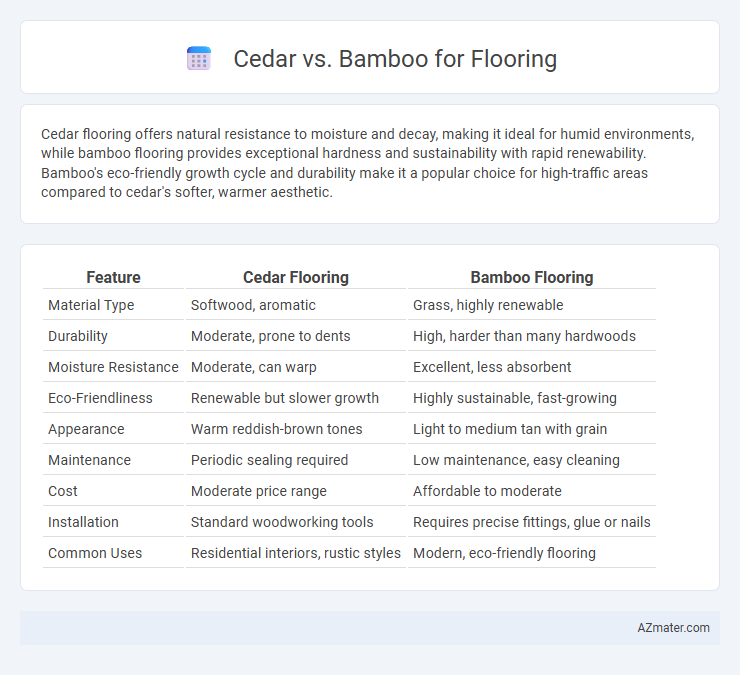Cedar flooring offers natural resistance to moisture and decay, making it ideal for humid environments, while bamboo flooring provides exceptional hardness and sustainability with rapid renewability. Bamboo's eco-friendly growth cycle and durability make it a popular choice for high-traffic areas compared to cedar's softer, warmer aesthetic.
Table of Comparison
| Feature | Cedar Flooring | Bamboo Flooring |
|---|---|---|
| Material Type | Softwood, aromatic | Grass, highly renewable |
| Durability | Moderate, prone to dents | High, harder than many hardwoods |
| Moisture Resistance | Moderate, can warp | Excellent, less absorbent |
| Eco-Friendliness | Renewable but slower growth | Highly sustainable, fast-growing |
| Appearance | Warm reddish-brown tones | Light to medium tan with grain |
| Maintenance | Periodic sealing required | Low maintenance, easy cleaning |
| Cost | Moderate price range | Affordable to moderate |
| Installation | Standard woodworking tools | Requires precise fittings, glue or nails |
| Common Uses | Residential interiors, rustic styles | Modern, eco-friendly flooring |
Introduction to Cedar and Bamboo Flooring
Cedar flooring offers natural resistance to moisture, insects, and decay, making it a durable and aromatic choice for indoor spaces. Bamboo flooring, derived from fast-growing grass, provides an eco-friendly, renewable option known for its hardness and modern aesthetic. Both materials vary in cost and installation methods, appealing to different preferences in sustainability and design.
Key Differences Between Cedar and Bamboo Flooring
Cedar flooring is known for its rich aromatic scent, natural insect resistance, and warm reddish tones, making it ideal for cozy interior spaces. Bamboo flooring offers exceptional hardness and durability, with a lighter, more uniform color and eco-friendly rapid renewability, suitable for high-traffic areas. Moisture resistance is another key difference, as bamboo generally handles humidity better than cedar, which can be prone to cupping and swelling.
Durability: Cedar vs Bamboo Flooring
Bamboo flooring offers superior durability compared to cedar due to its hardness and resistance to dents and scratches, making it ideal for high-traffic areas. Cedar is softer and more prone to dents and wear but naturally resists moisture and insects, offering longevity in specific environments. Bamboo's tensile strength and ability to withstand heavy use generally result in a longer lifespan for flooring applications.
Sustainability and Eco-Friendliness
Bamboo flooring is highly sustainable due to its rapid growth cycle, regenerating in 3-5 years without requiring replanting, making it an eco-friendly alternative to traditional hardwoods. Cedar, while renewable, grows more slowly and harvesting can impact old-growth forests if not managed responsibly, reducing its overall sustainability. Bamboo's carbon sequestration capabilities and minimal need for pesticides further enhance its green credentials compared to cedar flooring options.
Aesthetic Appeal and Design Versatility
Cedar flooring offers a rich, warm hue with distinctive grain patterns that enhance rustic and traditional interior designs, while bamboo flooring provides a sleek, modern aesthetic with a uniform texture suitable for contemporary spaces. Bamboo's natural variations and ability to be carbonized or strand-woven expand design versatility, catering to various color palettes and durability needs. Both materials complement eco-friendly design trends, with bamboo often favored for its rapid renewability and cedar prized for its aromatic qualities and natural resistance to insects.
Installation Process
Cedar flooring installation involves tongue-and-groove planks that are nailed or stapled to subflooring, requiring acclimation to room humidity for several days to prevent warping. Bamboo flooring installation often uses click-lock or glue-down methods, with strand-woven bamboo demanding a moisture barrier and proper subfloor preparation due to its density. Both materials benefit from professional-grade tools and precise measurements to ensure tight seams and a smooth, durable surface.
Maintenance and Care Requirements
Cedar flooring demands regular sealing and occasional refinishing to maintain its natural oils and prevent moisture damage, making it moderately high-maintenance. Bamboo flooring requires less frequent sealing due to its dense structure and is highly resistant to scratches and stains, resulting in lower maintenance needs. Both materials benefit from routine cleaning with a damp mop and avoidance of excessive water to prolong their durability.
Cost Comparison: Cedar vs Bamboo
Bamboo flooring generally costs between $2 and $8 per square foot, making it a more budget-friendly option compared to cedar, which ranges from $5 to $15 per square foot depending on grade and quality. The lower price of bamboo stems from its rapid growth rate and abundant availability, while cedar's cost is driven by its natural resistance to decay and premium aesthetic appeal. Overall, bamboo offers a cost-effective flooring solution for large areas, whereas cedar is a higher-priced choice favored for its unique texture and durability.
Pros and Cons of Cedar Flooring
Cedar flooring offers natural resistance to moisture and insects, making it a durable choice for damp environments, while its warm reddish tones add a unique aesthetic appeal to interiors. However, cedar is softer than many hardwoods, leading to higher susceptibility to dents and scratches in high-traffic areas. Maintenance involves regular sealing to preserve its color and protect against wear, which can increase long-term upkeep compared to harder flooring options like bamboo.
Pros and Cons of Bamboo Flooring
Bamboo flooring offers exceptional durability and sustainability, as it grows faster than traditional hardwood trees and has a high tensile strength comparable to oak. It is resistant to moisture and insects, making it suitable for various climates, but it can be prone to scratching and may yellow over time if exposed to direct sunlight. While bamboo flooring is generally more affordable than cedar, it may lack the natural scent and warmth of cedar wood.

Infographic: Cedar vs Bamboo for Flooring
 azmater.com
azmater.com